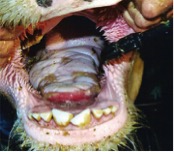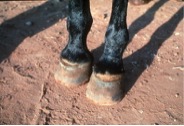
Vesicular Stomatitis (VS) UPDATE
Dr. Gregg A. Hanzlicek
Over the last few years there have been multiple Vesicular stomatitis (VS) cases in Arizona, Colorado, New Mexico, Texas, and Utah. A 2014 Colorado VS outbreak resulted in 556 livestock investigations and 370 facility quarantines. More recently, on July 2, 2015, two horses tested positive for VS in Colorado.
The VS virus can infect multiple species. The primary species include cattle, horses, pigs, but rarely include sheep, goats, and camelids. The virus is believed to be spread primarily through insect vectors such as black flies, sandflies, and mosquitoes, but the virus can also be transmitted through contact with VS lesion secretions. The transmission of virus is thought to occur only for a very brief period of time after clinical signs are observed.
The incubation period is estimated to be between two to eight days, and the classical clinical signs include vesicles, ulcers and sloughing of the skin on the muzzle, tongue, teats and the coronary band (Figures 1 and 2). Typically, the initial observation reported by an animal owner includes anorexic and/or lame animals, and not the observation of vesicles or ulcers.

Figure 1. Bovine VS |
|

Figure 2. Equine Coronary Band Photos courtesy ofColorado State University Extension |
One of the most important things to remember about VS is that it presents clinically very similar to Foot-and-Mouth Disease (in cattle, horses and pigs), Swine Vesicular Disease and Vesicular Exanthema of swine. KSVDL strongly recommends veterinarians call their local APHIS/veterinary services veterinarian to examine any animal presenting oral or extremity vesicles or ulcers. In all states, VS is a reportable disease regardless of the species of animal involved.
There have been very rare reported cases of human VS. These infections were presumably contracted through close contact with infected animals. In humans, the most common presenting clinical sign is not vesicles and ulcers, but flu-like symptoms.
There are two primary VS strains in the U.S.: New Jersey and Indiana. Regardless of the strain, research indicates that horses will seroconvert between six to 12 days after infection. (Experimental Vesicular Stomatitis Virus Infection in Horses: Effect of Route of Inoculation and Virus Serotype. E.W. Howerth, et al. Veterinary Pathology, 2006, vol. 43, pages 943-955.) Presumably, seroconversion timing is similar in cattle and pigs.
For an accurate VS diagnosis, in cattle, horses, and pigs, the appropriate sample to submit to KSVDL is 0.5 ml of serum in a preservative-free tube (red-top tube). This is a serum-neutralizing antibody test, which includes both New Jersey and Indiana strains.
For more information about VS, other diseases or diagnostics, please contact KSVDL Client Care at 866-512-5650 or clientcare@vet.k-state.edu.
Next Article: The Diagnosis of Fungal Kerion in Dogs
Return to Index